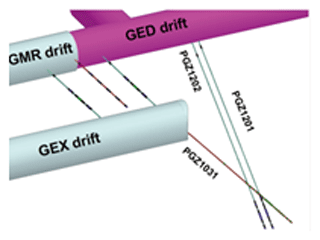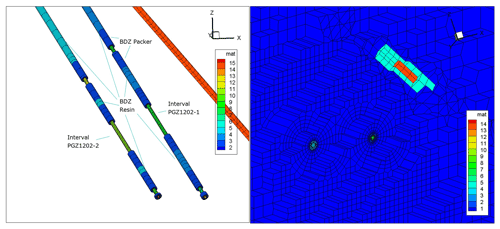Determination of the in situ hydraulic parameters of the Callovo–Oxfordian clay rock in a long-term hydraulic interference testing at Andra's Underground Research Laboratory (CMHM)
Between 2009 and 2015, Andra has conducted a unique long-term hydraulic interference test in two parallel boreholes 1 m apart from each other and air core drilled in the undisturbed Oxfordian Clay rock at Andra's Underground Research Laboratory (CMHM) in Bure, France. The experimental set-up consisted of six test intervals positioned along the parallel boreholes drilled from a drift located within the Callovo–Oxfordian clay at around 500 m b.g.l. (below ground level). The 20 m boreholes were oriented around 30∘ downwards. The pressure sensors linked to six intervals of 1 m length each allowed for continuous pressure measurement over 6 years and a slanted borehole for the observation of rock displacements (see Fig. 1). Additionally, flow rates were measured during water injection tests that lasted weeks or months. This extensive set of hydraulic data allowed, for the first time, a precise determination of the in situ Callovo–Oxfordian clay rock permeability and anisotropy and its specific storage at the metre to decametre scale. It was achieved based on an automated calibration, using a 3D flow model and explicitly considering all the relevant hydraulic elements acting on the flow system (such as rock mass, borehole disturbed zone and sealing elements) and the drift acting as a steady sink due to the underground ventilation (see Fig. 2). The history matching was performed on the transient pressure measurements. The obtained numerical calibration results were in close agreement with the hydraulic parameter values of the Callovo–Oxfordian clay determined at a smaller scale (single borehole tests and rock core samples in the laboratory), therefore demonstrating the reliability of the very low permeability of the Callovo–Oxfordian clay at the metre to decametre scale. Furthermore, the modelling illustrated the impact of the measurement set-up and its details on the observed hydraulic behaviour.
The analysis methodology and the main findings will be presented.







